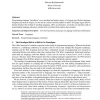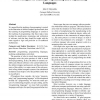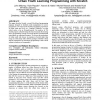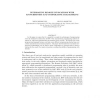ASE
2005
14 years 3 months ago
2005
Feature-oriented programming organizes programs around features rather than objects, thus better supporting extensible, product-line architectures. Programming languages increasin...
SIGPLAN
2008
14 years 3 months ago
2008
While the programming languages course played a key role in Curricula '68, '78, and '91, Curriculum 2001 replaced most of the content in programming languages with ...
SIGPLAN
2008
14 years 3 months ago
2008
Programming language "paradigms" are a moribund and tedious legacy of a bygone age. Modern language designers pay them no respect, so why do our courses slavishly adhere...
SIGPLAN
2008
14 years 3 months ago
2008
It is argued that the teaching of programming is central to the education of skilled computer professionals, that the teaching of programming languages is central to the teaching ...
SIGPLAN
2008
14 years 3 months ago
2008
Three key forces are shaping the modern Computer Science (CS) curriculum: (1) new topics/courses are squeezing out existing ones; (2) a focus on "big picture" and interd...
IJHPCA
2007
14 years 3 months ago
2007
A key characteristic of today’s high performance computing systems is a physically distributed memory, which makes the efficient management of locality essential for taking adv...
SIGCSE
2008
ACM
14 years 3 months ago
2008
ACM
This paper describes Scratch, a visual, block-based programming language designed to facilitate media manipulation for novice programmers. We report on the Scratch programming exp...
SIGARCH
2008
14 years 3 months ago
2008
Conventional programming models were designed to be used by expert programmers for programming for largescale multiprocessors, distributed computational clusters, or specialized p...
PPL
2008
14 years 3 months ago
2008
In this paper we argue that it is possible to couple the advantages of programming with the well-known abstraction of RPC with asynchronous programming models adequate for wide-ar...
MP
2006
14 years 3 months ago
2006
In classical two-stage stochastic programming the expected value of the total costs is minimized. Recently, mean-risk models - studied in mathematical finance for several decades -...




